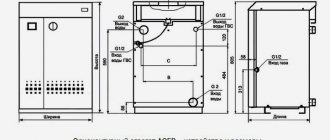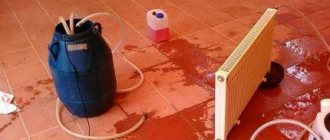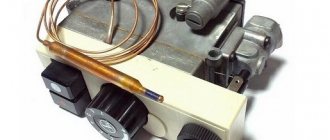There are frequent cases of a gas boiler taking too long to ignite, which is due to automation. Gas boilers, both Russian and foreign, are equipped with EUROSIT 630 valves, which serve as a set temperature controller and alarm in the event of an emergency. The valve automatically shuts off the gas supply to the burners. But then you can turn it on only manually. But this is not the only reason for the emergency.
Let us consider, as an example, boilers that have automatic protection against loss of fire on the igniter and disturbance of draft.
All work associated with the danger of a gas explosion must be carried out by specialists from enterprises with the appropriate permit. You can only monitor the progress of the work.
So, EUROSIT 630 has three modes - shutdown, ignition and temperature controller.
- To ignite the igniter, you need to move the control knob to the primary position, then press it using a button with a piezoelectric element. In this way, a dense burner is ignited. By the way, you need to hold the handle for 5 seconds. When the igniter lights up, it should continue to support the combustion process; if it goes out, repeat the ignition procedure. If, after several attempts, the combustion still stops, you should begin searching for the cause of the malfunction.
The fact is that the igniter is ignited, the flame must warm up the thermocouple, which will lead to the formation of an EMF, which will be sufficient to reach the sensor circuit, and then the solenoid valve.
- If you press the gas valve handles, the EM valve will open, causing gas to flow to the igniter. With the correct and proper functioning of the equipment, the EMF thermocouple will be able to hold the gas, and the valve will remain open. The thermocouple acts, in a sense, as a fuse against gas loss. Optimally closed indicators are built into the circuit, which are sure to work, thus opening the contacts, and also, in case of problems, turning off the boiler.
Igniters for boilers operating on gas AOGV Zhukovsky. General review.
Igniters for boilers operating on gas AOGV Zhukovsky. A short excursion. Posting date 01/27/2016
Introduction
The flashlight was a device used to ignite the charge in a cannon. The gun in our case is the boiler burner, which is ignited by our igniter. She seems to light a cigarette from his constantly burning flame. Moreover, after the burner has lit, the igniter also continues to work. Having worked for the required time to reach the temperature specified by us, the burner turns off. The boiler pilot light continues to burn. And these cycles of lighting and turning off the burner are continuous for the entire period of operation of the boiler. In addition to performing the function of igniting the boiler burner, the igniter performs another serious mission - it heats the gas control thermocouple. If for some reason the igniter flame goes out, it blows out, or something else happens, the heated thermocouple will cool down, stop producing thermo-EMF, after which the solenoid valve will turn off, which, in the open position, allows gas access to the boiler. Now there is no point in describing how all the automation works, but if you are interested in this particular moment, you can read it in detail here. Those. in fact, as long as the pilot light is on and the entire boiler is working. The pilot light went out and the boiler turned off. This cyclicity is present in all non-volatile gas automatics, no matter what they are and no matter what gas boilers they are installed on.
In various types of non-volatile automatic equipment installed on AOGV boilers of the Zhukovsky plant, the igniters are different. Here we present those components that we already know quite well. It may be that it will soon be possible to continue improving knowledge on a similar issue.
Problems
It is worth noting right away that we do not know of a single boiler malfunction that is directly related to the igniter itself (or the pilot burner, as it is also called). There are some variants of problems that occur, but the methods for solving them do not pay attention specifically to the igniter.
For example:
1. Do you have to agree that a crooked flame sticking out in all directions from the end of the igniter is not a malfunction? 2. And when gas flows to the igniter directly and immediately, without pressing the solenoid valve button, simply when opening the tap of the gas pipe that leads to the boiler, is this a malfunction of the gas block rather than the igniter? 3. And when gas oozes from under the pilot gasket and the boiler smells of gas, does this again have nothing to do with this poor tube with a jet at the end?
Smart?
Yes. This is all true. However, in such circumstances, it is again not the igniter itself that needs to be replaced, but only the igniter gasket, through which gas is leaking, and it is immediately necessary to replace the diaphragm of the upper valve in the Economy unit if the igniter continues to burn even when the solenoid valve button is released.
And practice itself constantly says that when the igniter flame, beating slightly to the side, suddenly begins to heat the control gas thermocouple insufficiently concentrated, which is so necessary for us to keep the solenoid valve in the open position, in this case the igniter definitely needs to be replaced .
Why?
In many cases, the pilot flame does not change quickly due to natural aging and the usual burnout of the tip (or jet). Firstly, people don’t always get around to it, and secondly, why do all this if the boiler is still working anyway? The answer to such questions, taking into account experience, is as follows: And so that there is no severe headache when another unexpected and complex problem appears. When the boiler simply turns out to be impossible to start, as they say, out of the blue. When, it seems, elementary problems will eventually become such a “complex lunch” that even correct diagnostics can easily come to a dead end and, as in most cases, we see, everything will begin to be replaced in a row, just to get the boiler started. Right up to replacing the boiler. And this is unacceptable. This teaches no one anything and is frustrating. This, so to speak, spits in the face of the repair professional and tells him that he doesn’t love the job. If one of the repair professionals advises you, making it clear that fatal, frequent problems require replacing the boiler with a new one, for us personally, with similar advice, he is in no way a winner, but a loser. What was the point of coming then? To recommend this professionally? As a result, we are here and draw our attention to various subtleties in a very special way, and the operation of the igniter of the AOGV Economy gas boiler is one of them, and, by the way, in the end it may turn out to be decisive. Especially when the boiler is not new, but has already served for a sufficient period of time. Such are the things.
Further
The goal of this work is to accurately and quickly determine and order the igniter that is installed on your boiler . The diameter of the fitting for connecting igniters on the Economy unit, both old and modern types, is M 12 external thread. All igniters of the old type, without exception, which were equipped with gas boilers with the domestic Economy block, produced before 2002, are called by the plant and by us “ Ignition Unit ”.
Device
In our case, the igniter is an ordinary copper tube, with a jet at one end and a nut at the other end for connecting to the Economy block.
Old sample
If you unscrew the Tip nut, a traditional jet is hidden under this design.
The fun begins when looking at the Igniter Assembly Tip. On this reinforced element we see a couple of holes, the purpose of which we need to remember. This can be of great help in understanding how it works, and also in cleaning it properly.
According to the numbers in the photo: 1. This is a hole for equipping air suction into the igniter flame. Without them, it is almost impossible to ensure stable combustion. There are two similar holes. They are located directly opposite each other. 2. This hole provides us with heating for the thermocouple. And it is precisely this that must always be superbly clean. 3. This hole is necessary for lighting the main burner. 4. These holes are necessary for the constant burning of the flame in hole No. 3. Without them, this is simply impossible. These are like holes that “transmit” the flame further.
New sample
There is no tip and only a “naked” jet is placed at the end. He is “naked”, i.e. without various protections due to the fact that the igniter flame goes up and turns with the help of the Gooseneck towards the thermocouple. This entire structure is shown in the photo below.
At the moment, when we are more or less familiar with the device and operating principle, we move on to presenting the samples of spare parts themselves in this section. The igniter units known to us are distinguished only by their length. They are all similar in design. Below we present the information that we know. Measurements are approximate and are provided as a guide. There are no surprises here.
Old sample
1. For any gas boiler AOGV-11.6 Economy produced before 02/01/2002. The length from the lower bend to the nut in a straight line is 38 cm. Article 336010.
2. For all boilers operating on gas AOGV-17.4, AOGV-23.2 and AOGV-29.1 Economy release until 01.06. 1996. Length from the bottom bend to the nut in a straight line 59 cm. Without article.
3. For all boilers operating on gas AOGV-17.4, AOGV-23.2 and AOGV-29.1 Economy release from 01.06. 1996 to 02/01/2002. Length from the bottom bend to the nut in a straight line 50 cm. Article number 301041.
New sample
Modern igniters are structurally different from old igniters, as they have one more mounting option near the boiler burner.
1. Igniter for the gas boiler AOGV-11.6 Economy produced from 02/01/2002 to the present day. The length from the bottom bend to the nut in a straight line is 41 cm. Article 390004.
2. Igniter for boilers operating on gas AOGV-17.4, AOGV-23.2 and 29.1 produced from 02/01/2002 to the present day. The length from the bottom bend to the nut in a straight line is 54 cm. Article 364021.
The right way to determine the type of igniter on your boiler (we are talking about ZhMZ Economy boilers)
Important! If it is not possible to determine the year of manufacture of the boiler, there is an accurate way to determine what type of igniter is installed on your boiler - an old or new model. It's done like this. It is necessary to compare the diameter of the thermocouple (and in Zhukovsky Economy boilers it is always the same - 6 mm) and the diameter of the igniter tube. With the old type, i.e. The igniter assembly has a tube diameter similar to that of the thermocouple - 6 mm. But a modern igniter has a significantly thinner tube - 4 mm. This is very quickly done purely visually. How fast, look at the next photo, where there is a thermocouple on the left, an igniter unit inside, and a modern type igniter on the right.
Everything we know about igniters for imported units for boilers operating on gas AOGV Zhukovsky
1. Ignitor for boilers operating on gas AOGV 17.4 AOGV 23.2 and 29.1 models Universal SIT (with Eurosit 630 block). The length from the bottom bend to the M 10 fitting in a straight line is 69 cm. Article number 428005.
2. The pilot burner can hardly be called an igniter.
This is a specific design, which is a unit that combines an igniter flame divider, a control gas thermocouple, a thermogenerator and an electrode. However, it contains space only for gas-fired boilers AOGV-29, 43 and 50 Comfort with SIT 820 Nova and Honeywell units (VS8620C1011B), located and fixed at the very bottom of the boiler. If you have a modern type AOGV 29.1 Comfort Mertik model (2010 and younger), where the valve is fixed inside the boiler body, we don’t yet know anything about igniters for these models.
And for other igniters, say, for AOGV Comfort release boilers since 2002 with a Honeywell gas valve, with a power of 17 and 23 kW, there is currently no information. All newly introduced additions to this section will be dated, since the information is frankly insufficient and there are variations of boilers with foreign gas blocks, about which we still know little.
The situation with Zhytomyr
This brand is famous for its devices with piezo ignition. For an example of burner cleaning, the Zhytomyr 3 model, equipped with EURO SIT technology, is used.
The following list of tools is required for the operation:
- Screwdriver. A flat tip is required.
- Open-end wrenches.
- A regular brush and its analogues for cleaning metal products.
- Yorshik.
After blocking the gas with a key, remove the screw securing the boiler door. It is removed entirely. This way the core of the unit becomes open.
The main burner is concentrated in its lower zone. To remove it and subsequently clean it, you need:
- Disconnect the cable from which the piezoelectric element and electric ignition operate.
- Use a key to remove the thermocouple and its clamp from the valve.
- Mark with a marker the distance of immersion of the nozzle into the burner itself. This will make it easier to return it to the correct position.
- Unscrew the nut securing the valve to the burner. Communication goes through a copper tube.
- Carry out the same manipulations with the ignition electrode.
- Using a screwdriver, remove the two fixing nuts of the other burner (pilot). There is a gasket underneath. If it is damaged or deformed, replace it.
- Remove the nozzle from the burner. If the process is difficult, gently tap around this part with a key.
To dismantle the main burner, the screw connecting it to the boiler body is released. Then it is removed. To do this, you need to grab its lower part and the copper tube and sharply pull it out of the valve.
The screw that fixes the insertion distance of the nozzle part is loosened.
For the cleaning itself, a brush and a brush are used. Carbon deposits are carefully removed.
A vacuum cleaner is used to clean the holes. All work affects both external and internal components.
This algorithm is also suitable for the procedure with the burner of the Dani AOGV series devices, for example -11.5; 23.2 and 29.
You can do the same with many similar units: Aton AOGV 16-EM, ZhMZ-AOGV 17, etc.
The injectors also need to be cleaned. Carbon deposits from the top side are removed with a brush. A wire or thin needle is used to clean the holes.
After this, all the parts are assembled using the reverse algorithm.
Pilots and gas burners for boilers
The igniter and burner are one of the most important components included in the design of gas-fired boilers. Their main purpose is to put the boiler into operation and heat it up.
Igniters for gas-fired boilers
The igniter of a gas boiler is a hollow copper tube, at one end of which there is a nozzle, and at the other there is a clamp (a piece of pipe for connections) for connection to the automation unit.
The igniter is designed to pass gas through itself and continuously maintain a burning torch to heat the thermocouple and start the main burner.
The igniter replacement occurs in two variations:
- when it becomes clogged with various debris present in natural or liquefied gas
- in case of mechanical damage
Burners for boilers AOGV, AKGV and KOV-SG
Over the entire history of production of Zhukovsky AOGV/AKGV boilers, 4 types of burners were used. They can be classified according to their design and materials from which they are made.
The very first boilers were equipped with a cast-iron round burner, reminiscent of a car steering wheel. Then there was a short period when a steel burner produced in St. Petersburg was used. Modern boilers use two types of burners - 7- and 13-nozzle stainless steel made in Italy by Polidoro. These burners are included in the design of all AOGV/AKGV gas burners produced today at JSC ZhMZ.
The most powerful boilers 43, 50, 68 kW of the KOV-SG series are equipped with a slot burner made of stainless steel, the production of which is established at JSC ZhMZ. The main design advantage of Polidoro burners is their ability to be converted to liquefied gas by replacing the nozzles on the burner itself.
The main task of the burner of a gas boiler is to heat the heat exchanger tank, or, to be more precise, its part located below - the fire box.
Replacement of the burner is done, for the most part, after its service life has expired. This can be determined by the following signs:
- uneven intensity of torch burning (flame pulsates)
- burning of the torch is not on the entire plane of the burner or beyond (through cracks)
- soot formation
In order to properly purchase a burner for a boiler or igniter, it is important to know what power and series the boiler is, its month and year of manufacture.
Thermocouple device
The equipment consists of two conductors, for the manufacture of which different alloys are used. Each has its own resistance and electrical potential. The conductors contact at one or more points (in some models, a compensating wire is responsible for this). The design of the thermocouple is simple:
- cast head housing with cover;
- phosphorus pads - compensate for the linear expansion of the electrodes;
- tip – isolates the working junction;
- a protective tube, including working and non-working areas.
The connecting wires pass through a fitting with an asbestos seal. Typically thermocouples are made from base metals. If the electrode is made of noble material, then phosphorus or quartz tubes are used.
The error of such a device is one degree, which is quite a lot for heating equipment. It all depends on the design features - the plates and conductors are connected in different ways. This can be spot welding, soldering or crimping. If the junction of two conductors is of poor quality, the error increases. Therefore, if you plan to replace a thermocouple, you should choose a new one from trusted manufacturers.
Cleaning the heat exchanger of a double-circuit boiler with your own hands: 5 nuances
In order for the boiler to serve for a long time, it should be cleaned regularly. Cleaning, or as it is also called, washing the heat exchanger of a single-circuit or double-circuit gas boiler at home can be done using chemical or mechanical methods. Similar cleaning is necessary in order to remove all internal deposits that can destroy the metal, and this can lead to disruption of the thermal process in the heating system itself. Then this problem will arise, like the supply of hot water to the main heating system - DHW. As a result, prevention of scale and other deposits is done regularly.
Chemical compositions
How to flush the heat exchanger of a gas boiler?
The safest option is citric acid. Industrial products for washing the heat exchanger of a gas boiler - Cillit, DETEX, Sanax. Hydrochloric acid is more effective. But its use is more dangerous for both the user and the system. Concentrated acid can destroy the internal protective layer of the heat exchanger and also increase the fragility of the metal.
External treatment of contaminated parts is carried out with special compounds to remove soot and carbon deposits. As a last resort, you can use household detergents.
Video about flushing the heat exchanger of a gas boiler.
Periodic flushing of the gas boiler heat exchanger is a basic requirement for the maintenance of heating equipment. Cleaning significantly affects the smooth operation of the entire system and greatly extends the life of the home heating device. When do you need to do flushing and can you do it yourself?
When a gas boiler operates, a layer of scale forms, which prevents the necessary cooling of the heat exchanger. In this case, the circulation pump takes on a greater load. Therefore, without flushing the heat exchange device, the heating unit may fail.
At home, cleaning should be done every two years. If the water in your home is quite hard, it is recommended to reduce the interval between flushes.
The first signs for the user of the need to flush the heat exchanger are:
- long-term heating of a gas boiler;
- reduction in thermal output;
- partial heating of the system;
- presence of extraneous sounds during operation of the heating device;
- significant increase in gas consumption.
When scale appears in double-circuit boilers, the water may not fully warm up or the pressure level may decrease.
It is advisable to avoid a combination of such symptoms. But if alarming signs appear, flushing should be done immediately.
In addition to internal cleaning of the heat exchanger, external cleaning of its body from soot is used. Socialized services are responsible for eliminating scale and contamination in the gas boiler system. The cost of their services is not cheap. Therefore, sometimes you can wash the heat exchanger yourself.
When you need to clean a gas boiler: negative factors
Gas boilers are currently becoming very popular and are in great demand. This happens due to the fact that this device is very profitable and economical, and it can heat not only houses outside the city, but also apartments. But in order for a similar device to work stably, without various interruptions, you need to regularly worry about it.
You can clean your gas boiler yourself or ask a professional
A double-circuit boiler can be cleaned in 2 stages. The first of these is mechanical cleaning of soot from all external surfaces of parts and chimneys. The second stage is chemical washing of all parts from scale.
A double-circuit boiler needs to be cleaned more often than a single-circuit boiler, since mineral deposits settle on its walls more vigorously. Why do we need to clean the boiler, and what signs will show us this?
Signs indicating cleaning of the AOGV or AGV boiler:
- Insufficient traction;
- The burner does not burn well or does not ignite in any way;
- Less heat transfer;
- The boiler gains temperature very slowly;
- Looking through the viewing window, we found traces of soot.
You can do the flushing of various types of boilers yourself, or you can go to a special workshop, where they will do everything carefully and correctly for you in a matter of hours. If cleaning does not help to cope with more than these problems, then you have to repair the boiler.
Flushing
How to clean the heat exchanger of a gas boiler from scale with your own hands? If there is a small amount of plaque inside, you can get by with manual washing using a citric acid solution.
If there is a thick layer of scale, you will need a washing unit that will circulate the detergent for several hours. A 10-liter tank with a pump is suitable for this purpose (you can use a circulation pump from the circuit). Two hoses from the pump are connected to two heat exchanger pipes.
There are three cleaning methods:
- mechanical;
- chemical;
- hydrodynamic.
In the first case, you can use a brush, scraper, or vacuum cleaner to remove plaque. Heat exchanger parts are pre-soaked in cleaning solutions.
During chemical treatment, an acid wash solution is pumped into the system using a booster and driven through a heat exchanger for several hours. Acidic solutions are good at removing ferrous and carbonate sediment. At the end of cleaning, the product is drained and a neutralizing agent is added.
The hydrodynamic method is the injection of water with abrasives into the system under pressure. In this way, the internal surfaces are cleaned mechanically, but the cleaning efficiency is higher than when processed manually. Flushing can be done without dismantling the system, but it is quite expensive. When cleaning yourself, you need to monitor the pressure in the circuits to avoid rupture of the heat exchanger.
How to clean a gas boiler: some nuances
Before you begin the process of cleaning a gas boiler, you first need to find out what parts will be involved in this. First of all, you will need to clean: the gas filter, the burner with nozzles, the jet, the igniter, the firebox and the chimney. Any of these parts must be cleaned according to your personal specifications.
Scale can accumulate in the passages of the heat exchanger, but soot appears in the chimney and other smoke exhaust channels. It follows from this: in order for the boiler to operate without interruptions, it is necessary to clean not only the main heat exchanger, but also all the inherent smoke channels, the flue, and with it the burner.
When starting to clean a gas boiler, it is important to know and take into account some nuances, without which it will not be possible to achieve particularly high-quality work. It is important to know them in order to do everything according to the rules in the future, without any mistakes.
Small details that are important to know:
- When flushing the boiler, you need to make sure that it is disconnected from gas, water and electricity;
- When dismantling the heat exchanger, it is contraindicated to damage the special sealing parts;
- The heat exchanger must be cleaned very carefully so as not to damage its thin tubes;
- The first thing you need to do is check the tightness of all connections;
- In aggressive solutions, it is primarily necessary to add various stabilizers to protect iron parts.
You can clean the boiler using a special brush.
Before you start cleaning a gas boiler from any company: Baxi, Aton or Vaillant, you must first disassemble the boiler so that you can get to each of the parts, we will need them. Disassembling the boiler is quite easy if you know its structure. You can do this yourself, having first read the instructions with well-deserved attention.
Principle of operation
The thermocouple is synchronized with the inlet valve - it is the one that gives the signal to stop the fuel supply.
It is based on the Seebeck effect. Its essence:
- two dissimilar conductors form a closed circuit;
- the junction points are affected by different temperatures;
- a thermoelectromotive force is generated in the circuit.
The latter does not appear immediately. The mechanism works like this:
- One side of the conductor is heated, which is why the electrodes move faster on it than on the cold side. As a result, higher energy flows to it.
- The energy acts on the electrodes, “pushing” them towards the cold conductor, which accumulates a negative charge.
- The hot side retains a positive charge.
- The charge accumulates until the potentials differ. Electrons from the cold side move back to the hot conductor.
- The final stage of the process is balancing.
The thermoelectromotive force is affected by the following factors:
- temperature indicator at the contacts;
- What is the conductor made of?
The working side of the thermocouple (the area where the conductors are connected) is immersed in a temperature-controlled environment. At this time, the non-working junction is connected to the measuring device. To measure potential differences, a millivoltmeter is used, which allows you to calculate the indicators in the usual degrees Celsius.
Additional Information! To connect a thermocouple to a measuring device, special thermocouple wires are used (their material is similar to conductors).
Detailed instructions on how to clean the igniter for a gas boiler
If the igniter flame is cone-shaped and bright blue in color, then we conclude that this is its normal operation. But if the fire has already acquired a yellow or orange tint, then this indicates that the igniter needs to be cleaned. You can clean the igniter yourself, but disassembling the entire boiler is not necessary.
The igniter is considered an automatic device for a gas boiler; it is used to ignite the burner. This part plays a major role in the operation of the entire device. The entire heat exchange process depends on its normal operation.
The igniter, or also called the wick, should ignite very softly, without any pops. If you hear a small pop, like someone shooting, it means that the igniter has broken down or just needs to be cleaned.
Step-by-step cleaning of the igniter:
- We shut off the gas supply;
- We unscrew the igniter itself;
- We clean it thoroughly with a special metal brush;
- Then we blow;
- We install the part in place.
To properly clean the igniter of a gas boiler, you need to watch the Video Training in advance
Before you start cleaning the igniter, you first need to unplug it. By doing regular maintenance of all parts, you will get long and reliable operation of the entire unit and at the same time enjoy the warmth when it’s cool outside.
Burner: cleaning gas nozzles yourself
The burner in gas boilers of various types is considered a significant part of the entire structure, since it performs the main function - supplying fuel. As a result, it should be cleaned first once a year, before the boiler is started.
The burner and jets can be cleaned separately, but it is better to do this in combination. When starting work, you should check whether you have disconnected the device from the gas, and only then proceed with the cleaning itself.
The burner includes nozzles that also need to be cleaned. Not only the heat in the room, but also the low consumption of all fuel, and in addition the operational period of this device, depend on a similar important detail.
Clean the burner and its nozzles:
- Turn off the gas supply with the key;
- Remove the burner from the installation site;
- Unscrew the injectors;
- Clean the injectors carefully with a brush;
- We clean the burner itself with a special brush, but its holes need to be blown out;
- Insert the nozzles into the burner;
- Install the burner in its old place.
You can also step by step clean all other parts that are responsible for the operation of the entire boiler.
Item Description
The thermocouple is practically the only device that measures extremely high temperatures. It is installed in various boiler equipment. The element’s task is to control the thermal regime, protecting the system from possible overheating.
If there is no flame in the combustion chamber for any reason, the thermocouple automatically shuts off the gas supply. That is, it is a protective element.
In general, a device that measures the temperature of the working environment is widely in demand in various areas of human activity: industry, medicine and other areas where accurate temperature is important.











